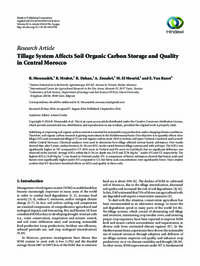Tillage System Affects Soil Organic Carbon Storage and Quality in Central Morocco

Authors:
Stabilizing or improving soil organic carbon content is essential for sustainable crop production under changing climate conditions. Therefore, soil organic carbon research is gaining momentum in the Mediterranean basin. Our objective is to quantify effects of no tillage (NT) and conventional tillage (CT) on soil organic carbon stock (SOCs) in three soil types (Vertisol, Cambisol, and Luvisol) within Central Morocco. Chemical analyses were used to determine how tillage affected various humic substances. Our results showed that, after 5 years, surface horizon (0–30 cm) SOC stocks varied between tillage systems and with soil type. The SOCs was significantly higher in NT compared to CT (10% more in Vertisol and 8% more in Cambisol), but no significant difference was observed in the Luvisol. Average SOCs within the 0–30 cm depth was 29.35 and 27.36 Mg ha−1 under NT and CT, respectively. The highest SOCs (31.89 Mg ha−1) was found in Vertisols under NT. A comparison of humic substances showed that humic acids and humin were significantly higher under NT compared to CT, but fulvic acid concentrations were significantly lower. These studies confirm that NT does have beneficial effects on SOCs and quality in these soils.
